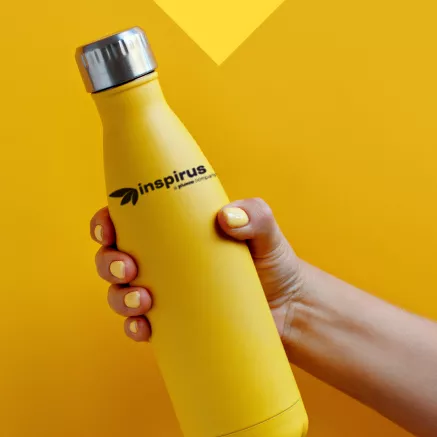A Comprehensive Guide to Employee Awards and Recognition Programs for a Motivated Workplace
Recognition is a powerful motivator in any type of relationship – especially ones in the workplace. Employee awards are a tangible expression of that appreciation and a way to drive home just how much each individual’s contributions matter.
Think about it this way: A really engaged employee commits not just their time from 9-5, but part of themselves: their vision, their passion and their unique talents. When an employee is supported in a way that allows them to bring their full selves to what they do, excellence abounds. And that commitment deserves acknowledgment.
Plus, authentic and meaningful recognition isn’t just good for the employee. It benefits the company as a whole. Employees who are recognized are almost six times more likely to stay at their jobs than those who aren’t, according to Zippia, while more than a third of employees say that acknowledgment is the most important thing a manager can do to motivate them to produce great work.
Employee recognition awards and programs are essential components of a thriving, successful workplace culture. When employees feel appreciated and valued, they are more likely to be committed to their work and to go above and beyond to contribute to the success of the organization. Here are some of the most effective ways to acknowledge and reward excellence to create a more motivated workforce.
Types of Employee Awards
There are many different types of employee awards from gifts to public recognition ceremonies to other incentives. Choosing the right one will depend on the situation and the culture of your organization.

The most popular types of awards include:
- Service anniversary awards
- Achievement awards
- Innovation awards
- Leadership awards
- Performance awards
- Customer service excellence awards
- Employee of the month awards
- Peer-to-Peer recognition awards
Employee awards for these celebratory moments can take many forms, from formal recognition to simple gestures of appreciation. A formalized recognition program can help ensure that all employees are equally and fairly rewarded, with no one falling through the cracks. If one employee received a gift for their birthday or service anniversary, their colleagues all should, too.
What kind of tangible rewards do employees find most motivating? Here are some recognition award ideas:

Gifts
Quality merchandise from top brands is always exciting, especially when the employee can choose from a selection of options.

Recognition Events
Hosting a special event to recognize and celebrate the employee's achievements can be a memorable and motivating reward.

Financial Rewards
This includes cash bonuses, profit-sharing or stock options.

Company Swag
Branded items like t-shirts, water bottles, coffee mugs and other swag can be a fun way to show appreciation while also building a sense of company spirit and pride.

Experiences
This can include tickets to events, travel packages, meals at a restaurant, a weekend getaway or other special rewards that create memorable experiences.

Extra Vacation Days
Who doesn’t love additional paid time off to relax and recharge?
While tangible rewards are incredibly effective motivators, non-tangible rewards like public recognition, personalized thank you notes and opportunities for professional growth are also highly valued by employees. The key is to understand what motivates each individual employee and to tailor rewards accordingly.
Budgeting for Employee Awards
Allocating the right budget is a crucial aspect of creating a successful, long-standing employee awards program.
How much money should you allocate to employee recognition? That will vary depending on the size and resources of your organization. The Society for Human Resource Management (SHRM) recommends at least one percent of your total payroll.
Beyond that, though, there are also several cost-effective ways to implement recognition programs that will still have a significant impact on employee morale and engagement. From do-it-yourself employee appreciation gifts to verbal or written recognition, showing you value employees doesn’t have to break the bank.
To budget for an employee recognition program, consider the following steps:
#1 Assess your current recognition budget:
Begin by evaluating your current budget for employee awards and recognition, including the funds allocated towards any existing programs or initiatives.
#2 Identify key areas for investment:
Determine the key areas where you want to focus. This could be based on specific goals, such as improving employee engagement or reducing turnover, or it could be based on feedback from employees and managers.
#3 Allocate funds strategically:
Once you’ve identified your budget and your goals, be strategic in how you allocate those resources to get the most bang-for-your-buck. This can include focusing on non-monetary rewards, like public recognition or personalized thank you notes where it makes sense, or investing in technology to streamline the recognition process.
#4 Monitor and adjust:
As you implement your budget for employee awards and recognition, monitor the results and be prepared to adjust as needed.
When budgeting for employee awards, don’t forget to consider the long-term impact of recognition in the workplace – such as the value of increasing employee engagement, improving morale and reducing turnover.
Utilizing Technology for Employee Recognition
Creating a powerful recognition program requires thoughtful strategy and a methodical approach. Fortunately, there are tools and technologies available that can support successful programs, simplifying the process and enhancing its impact.
The benefits of leveraging technology for employee recognition and rewards include:
Increased Efficiency
Technology can streamline the process of recognizing and rewarding employees, making it easier for managers and HR to run the program – including when it comes to gifts and awards.
Greater Engagement
Technology can make recognition more fun and engaging, and can also make it easier for employees to participate in recognition programs, leading to greater engagement and participation.
Feedback
A platform with real-time feedback surveys integrated provides important data about the effectiveness and impact of the recognition program, in addition to revealing new opportunities.
Analytics and Reporting
Collecting quantitative and qualitative data allows you to measure the impact of your initiatives over time, identifying areas for improvement and benchmarking your employee engagement metrics against other KPIs.
Digital Platforms for Awards and Redeeming Rewards
One of the many benefits of using a digital employee engagement platform like Inspirus Connects is the ability to bring together remote, in-person and hybrid teams through the power of celebration and recognition.
The platform’s flexible, points-based system means that managers and program administrators can easily and seamlessly reward employees by sending points that can be redeemed for a wide variety of gifts. Employees can select items of their choice, from gift cards and branded merchandise to experiences or charitable giving. This facilitates creating a culture of appreciation and recognition in ways that have measurable impact.
Work Recognition Messages
Words matter and crafting effective, authentic messages is foundational to any employee recognition program. Whether you’re giving a congratulatory speech to accompany an award ceremony or penning a quick message to thank an employee for their contributions, the message makes a difference.
Personalized recognition has a significant impact on employee morale and engagement because it shows that their efforts are recognized and valued on an individual level. Messages should be specific, genuine and tailored to the individual employee – illustrating that the manager is paying attention and cares.

Letter of Recognition for Going Above and Beyond
If you’re unsure about where to start with appreciation messages, a recognition letter acknowledging a moment where they went above and beyond is a great option. Follow this general format, tweaking it where needed to make it more specific to the employee and the situation:
- Address the employee by name
- Express gratitude for specific contributions – include details about what exactly they did that went above and beyond.
- Share how their efforts positively impacted the team or organization.
- Highlight your appreciation for their hard work and dedication, encouraging them to continue their exceptional efforts.
- Thank them again for their contributions and express your confidence in their future success.
Even by itself, a message like this is powerful. Combined with a tangible reward or gift can leave a lasting impression, driving home how valued the employee is.

Employee of the Month Award
If you want to take recognition beyond a private message, consider implementing an Employee of the Month award.
This initiative is designed to acknowledge and reward employees who demonstrate exceptional performance, dedication and commitment. An Employee of the Month program can help to foster a positive workplace culture by celebrating the contributions of individual employees, while also motivating others to strive for excellence. It’s important to make sure that the criteria for selection is transparent and clearly communicated to the entire organization. It could be based on productivity, teamwork, customer service or innovation, or require nominations from colleagues or managers. Regardless of how the recipient is selected, all employees should understand what is expected of them and how they can qualify.
Consider giving the recipient a gift or other tangible reward, in addition to the public recognition.
Frequently Asked Questions
How do I set up an employee awards program?
Here’s how to get started. First, decide whether a technology platform is needed or whether it will be a manual process. Then, define your program’s goals, determine the types of awards to offer, establish criteria for award eligibility and set up a nomination and selection process. Make sure to account for the budget and resources required to successfully run the employee awards program.
What types of employee awards should I offer?
The types of awards you offer should depend on your organization's culture, values and goals. Some of the most popular types of employee awards include performance awards, service awards, innovation awards and peer-to-peer recognition awards. Try to include a mix of awards that recognize different aspects of employee contributions.
How do I ensure that my employee awards program is fair and inclusive?
It's important to establish clear and objective criteria for award eligibility. Create a transparent nomination and selection process, involving employees and managers in the process. If you are just launching a new employee award program, make sure to provide training and resources to help employees understand how to participate. Regularly review and evaluate the program, including soliciting feedback, to identify any potential biases or areas for improvement.
Other Helpful Resources About Employee Recognition and Rewards

Ten Best Practices for Employee Service Award Programs

The Importance of Employee Appreciation and Recognition: Driving Results in the Modern Workplace

12 Employee Appreciation Letter Samples to Boost Morale
